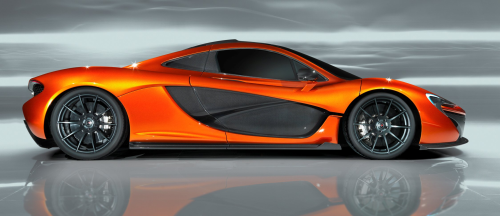
In Paris McLaren previewed a P1 design study. The company will reveal a production version next year, which it aims to put on sale within 12 months.
Aerodynamics a priority
The McLaren P1 was designed from the outset to prioritise aerodynamic performance and spent many hours in a wind tunnel and using CFD (computational fluid dynamics) aerodynamic modelling – just like a Formula One car.
McLaren says the P1 has much higher levels of downforce than any current road car – 600 kg is achieved well below maximum speed. That is approximately five times as much downforce as a McLaren 12C.
The P1 showcases McLaren Automotive’s advanced motorsport-based engineering, prioritising high performance through state-of-the-art technology. It will feature advances in weight reduction, packaging, high-speed performance, materials (especially carbon fibre), powertrain and in aerodynamics.
Lightweight carbon ‘multi-purpose’ body panels
The McLaren P1 is a mid-engine design that uses a carbon fibre monocoque and roof structure safety cage concept called MonoCage, which is a development of the MonoCell used in the current 12C and 12C Spider.
The structure of the MonoCage, unlike the 12C’s MonoCell, also serves to guide air into the engine through an integral roof snorkel and air intake ducts, saving further weight.
All the body panels are carbon fibre composite to reduce weight.
There are also very few body panels. The McLaren P1 has large clamshell single-moulded front and rear panels, which are attached to the central carbon MonoCage, and that’s it, apart from two small access flaps in the rear, a front bonnet and the two doors. This reduces weight and the number of shutlines, creating a cleaner appearance.
The large carbon composite panels are also multi-functional, with integrated scoops and ducts to boost aero performance and cooling.
The panels are extraordinarily thin and light whilst being very strong.
'Active' rear wing
The large rear wing adjusts automatically to boost downforce and optimise aerodynamics. It can extend rearwards by up to 300 mm on a racetrack, and by up to 120 mm on the road. The pitch of the rear wing can increase by up to 29°. The double element rear wing profile has been developed using the same methods and software as the current McLaren Formula 1 car.
In addition to the adjustable ‘active’ rear wing, the McLaren P1’s aerodynamic performance is optimised using two flaps mounted under the body ahead of the front wheels. These are also actively controlled, and change angle automatically to optimise performance, boosting downforce and aero efficiency, increasing both speed and driver confidence. The flaps operate through a range of 0-60°.
The rear wing and front flaps work together to boost handling, braking and straight line performance. The active aerodynamics ensures totally consistent handling and driving behavior. The rear wing can also act as an airbrake when deployed.
Further information:
- Watch the official McLaren P1 reveal film at www.youtube.com/McLarenAutomotiveTV
- See more pictures of the car here.






